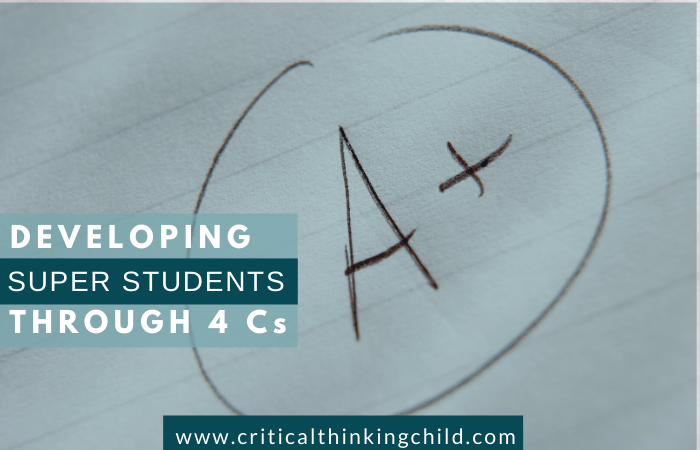Do you have a super student? You probably think so! But what is a super student, and how do you make sure your child develops the qualities that will allow them to succeed? The good news is that many of the qualities that make a student “super” can be nurtured both in the classroom and at home.
You may have heard about the 4Cs that make up today’s 21st century skills. These Cs (critical thinking, creativity, communication, and collaboration) set students up for success in today’s world. Learning these four skills will go a long way towards helping your child show up as a super student. In fact, teacher professional development sessions and teacher evaluation systems are often centered around these skills. You can support your child in these at home, so they show up ready to learn and grow.
Super students are critical thinkers
In his TED talk, educator Brian Oshiro suggests that critical thinking skills can be developed in students by asking them four questions:
- How or why?
- How do you know this?
- How does your perspective differ from others’?
- How should we solve this real-world problem?
These questions force students to go beyond basic comprehension questions and instead dig deeper into the reasons behind everything from scientific phenomena to character motivations and economic system. Asking about different perspectives allows students to argue intelligently and respectfully, and solving real-world problems lends an authenticity to their education experience.
Here at The Critical Thinking Child we help students learn how to evaluate their surroundings, ask questions, and experiment. We like to think of developing critical thinking skills the same way an athlete prepares for a game. It requires an understanding of the game, a willingness to practice, and a healthy dose of fun.
At home, you can help your child with critical thinking skills by asking the above questions around a strong interest of your child’s. This will increase their engagement level, and you can work together to discuss issues and pose solutions to problems. You can monitor their success through the TAP Method, and continue to challenge them in new, creative ways that make learning fun.
Super students are creative.
Creativity is crucial to success as adults; companies and organizations are always trying to find innovative ways of doing things, and employers look for fresh ideas and creative solutions to problems. You can support your child’s creative instincts at home by taking a step back. Your child may be a naturally creative learner, but even if they aren’t they can stretch those muscles. Parents and teachers tend to take charge and delegate tasks to students, but you need to do the opposite to foster creativity. Instead, pose an interesting question, project idea, or scenario, and let your child do the rest!
Your job is to facilitate your child’s learning, not control it. When your child has autonomy and independence they can come up with the most interesting and creative solutions. Sit back and enjoy!
Super students are strong communicators.
In addition to critical thinking and creativity, super students work well with others and communicate effectively. You can work on this at home by modeling how to have a productive discussion. Some great starting points are “I disagree because” and “I agree because.” The key word here is because. Show your child that having a different opinion is okay, but it’s important to communicate why they agree and disagree. You can start this at the dinner table with silly prompts like “Would you rather have really big feet or really small hands?”
In addition to speaking and listening effectively, it’s also important to be able to communicate in writing. You can help your child with this at home by making sure they always re-read their writing, even modeling that it’s important for adults to do this as well to make sure their writing makes sense.
Super students collaborate with others.
Strong communication skills are a stepping stone to effective collaboration skills. More than ever, classrooms are collaborative environments — and so are workplaces! To help your child work well with others, you can practice at home. For example, when working on chores, give each family member a specific role. Or if your child wants to start a club with their friends, help them set up jobs for each person, like timekeeper, questioner, note taker, and sharer. This will keep them focused on the task and hand and avoid one student doing all the work while the others watch.
Another fun way to build collaboration skills (and also creativity!) is through drama. You can give your children props and costumes and let them come up with their own play to create with their friends. This will encourage children to decide who gets each part, who is in charge of designing the scenery, and how they are going to present their play.
To nurture the 4 Cs at home: focus on your child and let them do the rest!
To truly nurture your super student at home, create engaging tasks, offer materials and support, and watch your child go! Making learning fun and open-ended will nurture critical thinking skills, creativity, communication, and collaboration.
Sources Used:
Edutopia, “4 Ways to Develop Creativity in Students”
Edutopia, “5 Strategies to Deepen Student Collaboration”
National Education Association, “An Educator’s Guide to the Four Cs”
Sun, “Supporting Super Students: Future Learning Using 4Cs Now”



